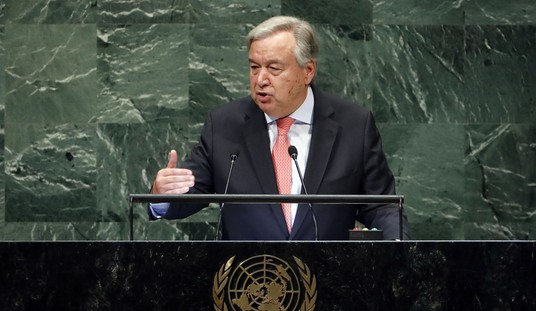Alternate headline: Clarence Thomas becomes Donald Trump’s new favorite Supreme Court justice. Should public figures have to surmount a higher level of evidence in order to prevail in libel and slander actions? Media outlets certainly want that to be the case, and public figures from Donald Trump on down often express their frustration over (allegedly) false reporting for which they have no resort.
Trump has at times insisted that Congress make it a lot easier for him and others similarly situated to sue for libel and slander. Today, in a lengthy concurrence on a refusal to grant cert in a defamation case filed by Katherine McKee against Bill Cosby, Justice Thomas says the Supreme Court should take action itself to fix the problem it created:
McKee filed suit in federal court for defamation under state law, but her case was dismissed. Applying New York Times Co. v. Sullivan, 376 U. S. 254 (1964), and its progeny, the Court of Appeals concluded that, by disclosing her accusation to a reporter, McKee had “‘thrust’ herself to the ‘forefront’” of the public controversy over “sexual assault allegations implicating Cosby” and was therefore a “limited purpose public figure.” 874 F. 3d 54, 61–62 (CA1 2017) (citing Gertz v. Robert Welch, Inc., 418 U. S. 323, 345 (1974)). Under this Court’s First Amendment precedents, public figures are barred from recovering damages for defamation unless they can show that the statement at issue was made with “‘actual malice’—that is, with knowledge that it was false or with reckless disregard of whether it was false or not.” New York Times, supra, at 280. Like many plaintiffs subject to this “almost impossible” standard, McKee was unable to make that showing. See Dun & Bradstreet, Inc. v. Greenmoss Builders, Inc., 472 U. S. 749, 771 (1985) (White, J., concurring in judgment).
McKee asks us to review her classification as a limited-purpose public figure. I agree with the Court’s decision not to take up that fact-bound question. I write to explain why, in an appropriate case, we should reconsider the precedents that require courts to ask it in the first place.
New York Times and the Court’s decisions extending it were policy-driven decisions masquerading as constitutional law. Instead of simply applying the First Amendment as it was understood by the people who ratified it, the Court fashioned its own “‘federal rule[s]’” by balancing the “competing values at stake in defamation suits.” Gertz, supra, at 334, 348 (quoting New York Times, supra, at 279).
We should not continue to reflexively apply this policy-driven approach to the Constitution. Instead, we should carefully examine the original meaning of the First and Fourteenth Amendments. If the Constitution does not require public figures to satisfy an actual-malice standard in state-law defamation suits, then neither should we.
Oh my. Not only does Thomas excoriate the Sullivan court for creating a standard that had never been considered by the original framers of the First Amendment, he points out that libel and slander had also been criminal violations during that period. The reason for that enforcement was to prevent breaches of peace, and that usually meant that enforcement was stricter when it came to public officials rather than looser:
Far from increasing a public figure’s burden in a defamation action, the common law deemed libels against public figures to be, if anything, more serious and injurious than ordinary libels. See 3 Blackstone *124 (“Words also tending to scandalize a magistrate, or person in a public trust, are reputed more highly injurious than when spoken of a private man”); 4 id., at *150 (defining libels as “malicious defamations of any person, and especially a magistrate, made public by either printing, writing, signs, or pictures, in order to provoke him to wrath, or expose him to public hatred, contempt, and ridicule” (emphasis added)). Libel of a public official was deemed an offense “‘most dangerous to the people, and deserv[ing of] punishment, because the people may be deceived and reject the best citizens to their great injury, and it may be to the loss of their liberties.’” …
The common law did afford defendants a privilege to comment on public questions and matters of public interest. Starkie *237–*238. This privilege extended to the “public conduct of a public man,” which was a “matter of public interest” that could “be discussed with the fullest freedom” and “made the subject of hostile criticism.” Id., at *242. Under this privilege, “criticism may reasonably be applied to a public man in a public capacity which might not be applied to a private individual.” Ibid. And the privilege extended to the man’s character “‘so far as it may respect his fitness and qualifications for the office,’” which was in the interest of the people to know. White, supra, at 290 (quoting Clap, supra, at 169).
But the purposes underlying this privilege also defined its limits. Thus, the privilege applied only when the facts stated were true. Starkie *238, n. 4; White, supra, at 290. And the privilege did not afford the publisher an opportunity to defame the officer’s private character.
Thomas doesn’t argue for a return of lèse majeste, but he does argue that the Sullivan court and the decisions that followed from it ignored 175 years of jurisprudence and common law. No one had promoted an actual-malice standard in relation to the First Amendment until then, when the Supreme Court created it on its own. That was an illegitimate action against the sovereignty of the states and their operation of libel and slander laws, Thomas writes; if states want to create that standard, they could do so legislatively.
Thomas makes a compelling case, one which should be read all the way through, and carefully. Even though I’m a conceptual supporter of Sullivan, the case Thomas makes for egregious judicial overreach is fairly convincing — especially as Thomas argues that the court could have found for the New York Times without inventing a higher threshold. Sullivan could easily join the pantheon of judicial-activist decisions that have become, as Amy Coney Barrett once put it, “super-precedents” despite a lack of true constitutional standing.
Could, that is, not will. There may be no end of public figures who would like to test Thomas’ resolve on reopening Sullivan, but don’t expect many of his colleagues to join him on the quest. Not only is Sullivan the kind of “settled law” for which stare decisis exists, it defends an undeniable public good — the ability to criticize our governing and celebrity classes, which have uncomfortably merged over the last few decades since Sullivan. If there was an immediate and handy replacement at hand for protection against lèse majeste attempts by public officials and the wealthy to shut down negative coverage, correcting the constitutional record might be worth it. But waiting for 50 states to take action would leave a lot of legitimate reporting at risk, even while truly malicious actions could still be remedied in court under the current standard.
I suspect that Thomas knows that this is going nowhere too. He’s just leaving an intellectual marker and warning against expanding Sullivan‘s boundaries even further. Having been the target of some very derogatory commentary himself, no doubt Thomas is also leaving a marker of a more personal kind here as well.








Join the conversation as a VIP Member